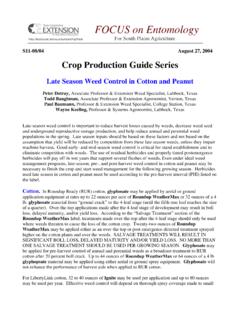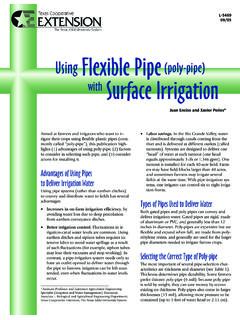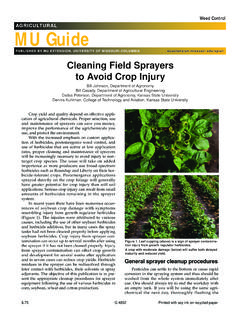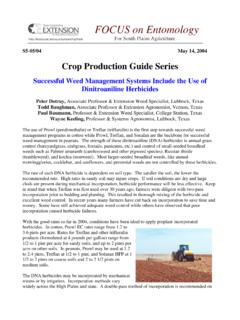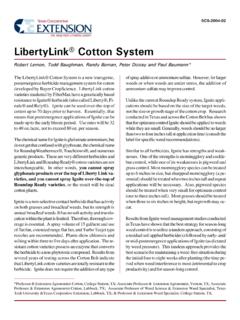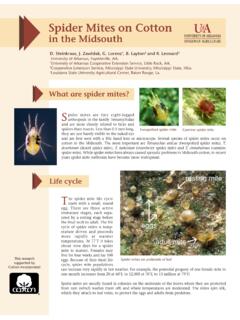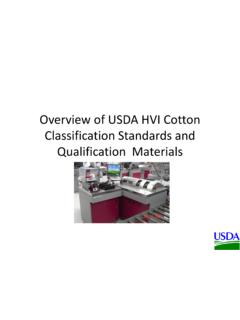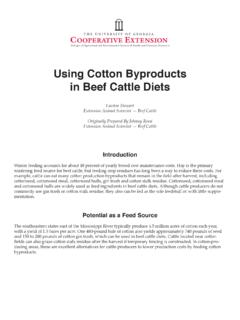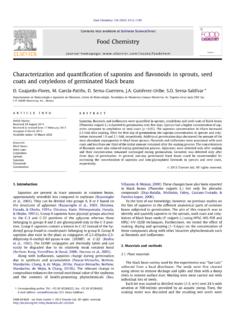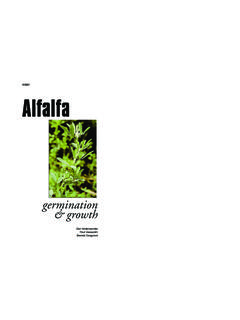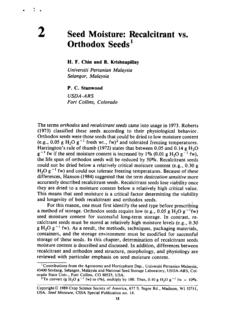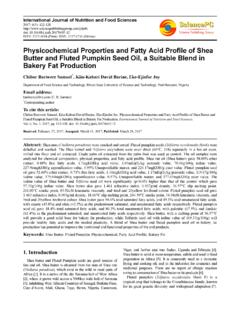Transcription of Weed Identification: 3-99 - cotton.tamu.edu
1 Paul A. BaumannProfessor and Extension weed Specialist, The Texas A&M University PlantStructures as a KeyWeed Identification: eed identification is necessary tothe success of any weed controlprogram. Frequently, simple plantkeys or picture book identification guides areused to identify weeds. However, some planttaxonomy keys can be quite complex and requirean advanced understanding of plant structureand taxonomic terminology. While more difficultto use, a detailed key or guide allows for theprecise identification of weeds. This handbook is intended for use as acompanion piece to better understand the plantpart terminology used in less complicatedidentification can be classified into one of threedifferent categories: broadleaves, weeds often are referred toas dicots; the seedlings produce two cotyledons(seed leaves) that are evident as the plant emergesthrough the soil surface.
2 Broadleaf plantsgenerally have wider leaves than grass plants andthe stems are often branched. Leaf veination isnetlike or has a branched sedgesare monocots; theirseedlings produce only one cotyledon (sometimesreferred to as the coleoptile in grasses). Grasseshave bladed leaves that are parallel veined andthis veination extends onto the sheath. In cross-section, the stems in grasses are usually roundor somewhat flattened. The stems of sedges, incross-section, are usually , relatively simple method of weedclassification is by the categories of annuals,biennialsor plants livefor one growing season and are often referred toas either summer annuals or winter annualsgerminate from seed in thespring, produce vegetative growth, set flowerand produce fruit mid- to late summer, and dieback in the fall. Winter annualsgerminate inthe late summer to early fall, produce vegetativegrowth, flower and produce seed in mid- to latespring, and die off in the summer.
3 2 Biennialsare plants that live for two years;seeds germinate in the spring, summer or fall ofthe first year and the plants overwinter usuallyas a rosette of leaves. During winter, the shoottips are exposed to cold temperatures for aperiod of time. This vernalization promotesnormal development of flowering and seedproduction during the summer of the secondyear. The plants then die in the fall. Perennialsare plants that produce vegetativestructures that allow them to live for three ormore years. These plants are classified as simpleor creeping perennialsspread primarily by seed; they cannot spreadvegetatively from underground roots. Creepingperennials, on the other hand, can reproduce bycreeping roots and also through seed creeping roots found above ground are calledstolons,the below-ground roots are calledrhizomes. Rhizomesare most common inperennial grasses.
4 In broadleafs or sedges, theseunderground root structures are referred to first step in identifying grass weeds is tobecome familiar with some key grass parts:the leaf blade, the collar, the liguleand ligulemay or may not be presenton some grass seedlings. The sheathis anextension of the leaf blade that terminates at thenode. The areas between the nodesare referredto as grass plants may haveextensions of the sheath called , however, generally does not have a liguleor an auricle. leaf bladeliguleauricleleaf collarsheathnodePlant Parts4 The cross-sections of grasses may be eitherroundor oval (flattened),compared to asedge, which exhibits a triangularshape. The sheathof a grass surrounding the stem isgenerally one of three types: split, overlapping,or liguleon a grass plant is a structure on theinside of the collar. It can be either membranousor hairy,or it may not be present at ligule may exhibit either a smooth marginor a toothed ,appendages found at the junction ofthe leaf blade and leaf sheath, may or may notbe lingulemargintoothed lingulemarginauricles presentauricles absent6 Pubescenceor leaf hairis often a key toidentifying specific grasses and can appear in several different areason a grass plant: only on the sheath margin, over the entire outside of the sheath surface, on the leaf collar margin, as a ring-like appearance surrounding thewhole collar, on the leaf blade margins or leaf edges, or only on the blade surface, with hair absent over the other parts of the plant.
5 Leaves or other plant surfaces without anypubescence whatsoever are often referred to as sheathmarginhairy sheathhairy collarmarginhairy collarhairy leafmarginhairy leafblade7 Arepresentation of a broadleaf plant with a fewkey descriptive parts labeled is shown leafterminal budleaf bladeleaf veinsalternate leaf arrangementpetiolestemcotyledonroots8 Broadleaf weed cotyledonsare a keyidentification feature. However, if cotyledonshave fallen off the plant or are in poor condition,they may not be helpful in broadleaf weedidentification. Various cotyledon shapes areillustrated above. linearoblonglanceolatespatulateovalround ovatekidneybutterfly9 Using cotyledons with true-leafidentificationfeatures can help in the overall weedidentification process. True leaves generallyexhibit one of several leaf shapes similar tocotyledons. filiformlinearlanceolateoblanceolatespat ulateobovateovatecordateoblongroundsagit tate10 Leaf margins(leaf blade edges) also are specialfeatures for identifying specific plants.
6 Examplesof entire, serrated, pinnately lobedandpalmately lobedleaf margins are shown. Pinnately lobed leaves can be distinguished frompalmately lobed leaves by examining the veinson the leaves. In a pinnately lobed leaf, the veinswill arise from several points along a centralaxis. Apalmately lobed leaf has veins that ariseat the same point at the base of the lobedpalmately lobed11 Leaf arrangement on the plant can be eitheralternate, oppositeor the stem is referred to in one ofthree ways: petiolate, where a petiole exists between the leaf, blade and the stem; sessile, where there is essentially no petiole and the leaf base is attached directly to the stem; or clasping,where the base of the leaf partially surrounds the leafletsmay be classified as eithersimpleor compound. Within compoundleaves, there exists either pinnatelycompoundor palmately compoundleafcharacterizations.
7 Leaf veinationis different for both grasses andbroadleaf plants. Veination in grass plants is aparalleltype. Broadleaf plants may exhibiteither a palmateveination or veinationpinnate veinationsimplecompoundpinnately compoundpalmately compound13 Some broadleaf plants may have other peculiarcharacteristics such as an is amembranous tubular sheath that surrounds thestem at the base of the structures also may beused as key plant identification basically stems that develop belowground. Plant shoots can arise from undergroundnodes on these stems. ocreasoil surfacerhizomenodes14 Tubersare thickened underground stems thatdevelop at the end of rhizomes. Stolonsareroots that grow horizontally above the often develop at the nodes of stolons andpeg down into the soil. New shoots also developat these surfacestolon15 These depictions of plant parts can serve as asimple guide to understanding theterminology in simple field guides or plant keysused for weed identification .
8 The use of morecomplicated keys for plant identification mayrequire a thorough understanding of plantvegetative and flowering programs of the Texas Agricultural Extension Service are open to all people withoutregard to race, color, sex, disability, religion, age or national in furtherance of Cooperative Extension Work in Agriculture and Home Economics, Actsof Congress of May 8, 1914, as amended, and June 30, 1914, in cooperation with the United StatesDepartment of Agriculture. Chester P. Fehlis, Deputy Director, Texas Agricultural ExtensionService, The Texas A&M University , NewWSProduced by Agricultural Communications, The Texas A&M University SystemExtension publications can be found on the Web at.
